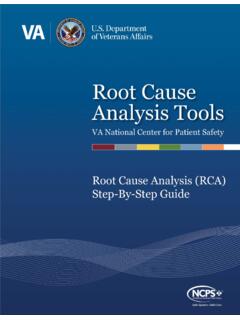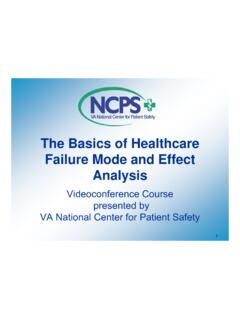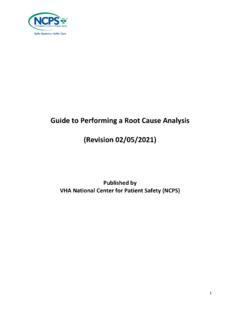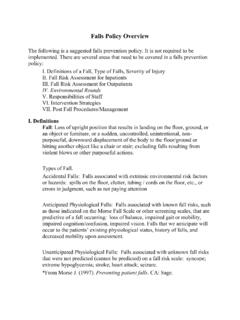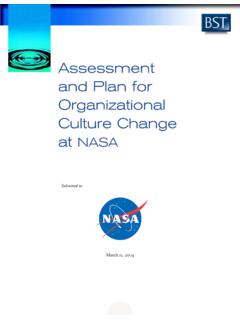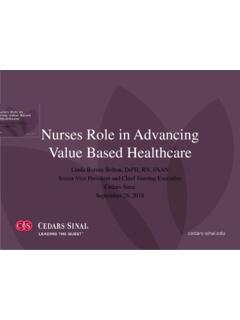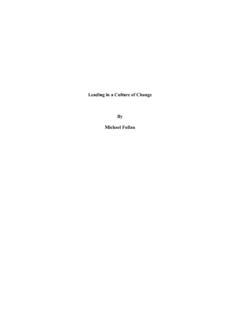Transcription of Just Culture - Veterans Affairs
1 1. VHA NCPS Culture of Safety and Just Culture Gary L. Sculli RN, MSN, ATP and Robin Hemphill , VHA National Center for Patient Safety Just Culture : A Just and Fair Culture is a necessary component of a Culture of Safety. A Just and Fair Culture is one that learns and improves by openly identifying and examining its own weaknesses; it is transparent in that those within it are as willing to expose weaknesses as they are to expose areas of excellence . In a Just Culture , employees feel safe and protected when voicing concerns about safety and have the freedom to discuss their own actions, or the actions of others in the environment, with regard to an actual or potential adverse event. Human error is not viewed as the cause of an adverse event, but rather a symptom of deeper trouble in an imperfect Leaders therefore do not rush to judge and punish employees involved in medical errors, but seek first to examine the care delivery system as a whole in order to find hidden failures and vulnerabilities.
2 For example if a nurse overdoses a patient while giving a medication with an infusion pump, all elements of the system will be examined rather than assuming the nurse s error was due to incompetent or negligent practice. Perhaps there were distractions in the environment, staffing shortages, high workload, fatigue, ongoing difficulties with programming the pump, or issues with the clarity of labeling on the infusion (See Fig 1).2 This is not to say that people are not accountable for their actions, and that there are not circumstances where discipline is warranted, but this is to say that a Just Culture does not default to punishing individuals. In fact, one can say that a critical aspect of a Just Culture is the perceived fairness of the procedures used to draw the line between conduct deserving of discipline and conduct for which discipline is neither appropriate nor helpful. Figure 1. Reason s Swiss Cheese Model of a System In James Reason s model, the Swiss cheese represents barriers or protections against error in the system.
3 The holes in the cheese represent latent or hidden failures. When the holes line up, an error occurs. It is this imperfect system with its failures that leads to error. 2. VHA NCPS Determining Accountability: One method that facilitates a Just Culture is James Reason s Unsafe Acts This algorithm can be simplified into the following four questions: 1. Did the employee intend to cause harm? 2. Did the employee come to work under the influence of alcohol or drugs, or equally impaired? 3. Did the employee knowingly and unreasonably increase risk? 4. Would another similarly trained and skilled employee in the same situation act in a similar manner? If the answer to the first three questions is no and the last question yes , then the accountability lies within the system. Even if the questions are not answered exactly this way, Reason s algorithm has within it deeper questions that clearly give the benefit of the doubt to the individual (See Figure 2).
4 The main point to stress here is that a Just Culture has a specific, fair, and non-arbitrary method of determining system vs. individual ,4 Improved Reporting: In a Culture of Safety individuals willingly report things that they believe to be unsafe. They will swiftly report errors in which they themselves have been involved. This occurs distinctly because they know the organizational Culture is fair minded, and leadership will not hold them accountable for failures in the system beyond their control. It assumes that they are competent and come to work each day with the intention to do the right thing. In this case people understand that reporting an error or unsafe condition is critical, even if there is no harm; as someone at some point in the future may experience the same conditions, and make the same error, which could result in an unfavorable outcome for a patient. In a Culture of Safety one feels a responsibility to report on safety issues.
5 Therefore, more reports within a system in one sense can be viewed as a signature of a Safety Culture . It is how those reports are dealt with that makes the difference between a Culture that seeks to be transparent in finding causation by examining itself as a system, versus one that seeks to quickly assign blame and take punitive action in the wake of medical error. Figure 2. Reason s Unsafe Acts Algorithm 3. VHA NCPS Human Reactions to Failure: An important element in determining causation after an adverse event is to avoid the natural human tendency to react to A Culture of Safety understands these reactions and will consciously make efforts to avoid them during a focused review of the event. Reactions to failure include: Hindsight Bias This reaction arises from the ability to look back at an event with full knowledge of the outcome. To avoid this, investigators must try to ignore this information and understand what those involved in the event at the time were experiencing, feeling and thinking.
6 Proximal Focus In this case the focus centers on people who were closest to or directly involved in the event; however, many times causation lies far away from the time and space where the event occurred. Counterfactuals This reaction usually begins with If only . If only the nurse had not selected the wrong concentration on the pump, the event would not have happened. This tells us nothing about cause. We need to understand why the nurse selected the wrong concentration. Counterfactuals simply lay out for us what people did wrong, nothing more. Judgmental Here snap judgments are made about what people did or should have done; negative words may be used. For example one might say, The physician is inept if he/she missed the patient s obvious history of bleeding. This is easy to do and tells us nothing about causation. Human Factors Engineering: As cultures move away from focusing on individuals and more on systems, they embrace the science of human factors That is attempting to design systems and equipment that fit the manner in which humans work, rather than attempting to force humans to adapt to suboptimal equipment, technology and ,5 For example, if hindsight bias is avoided, and we truly embrace an examination of the patient care system using human factors as a guide, we will often find that some process, software or hardware created conditions that were ripe for human error.
7 In a Culture of Safety, a human factors approach is manifest when examining adverse events and mishaps. Leaders Responsibilities: The job for setting the tone with regard to a Culture of Safety and a Just Culture rests squarely with top leadership. Leaders must send a message that talks about safety as a priority and back it up with , 6 They must openly encourage reporting, take the opportunity to reward those that do so, and be sure to provide feedback that steps were taken to change and improve unsafe conditions. Leaders must champion the Root Cause Analysis (RCA) process and openly encourage participation of all disciplines on RCA Key in supporting a Culture of Safety is the practice of leadership walk Here leaders simply walk around the facility and initiate informal conversations about safety issues or elements that front line staff perceive as barriers to safe care. Leaders then take this information and share it with department heads for discussion.
8 This information can be compared to already existing reporting systems and RCA data; then clear actions can be taken to resolve the concern. The final step in this process is providing feedback to staff that actions were taken to correct the issue; this makes it clear that discussions about safety are not just lip service and garners trust, which ultimately affects future reporting efforts. 4. VHA NCPS Team Training: An additional component in building a Culture of Safety is the initiation and sustainment of a robust team training program that includes the principles of aviation s Crew Resource Management (CRM) along with high fidelity clinical ,7 Healthcare is delivered in teams, and the manner in which teams communicate is frequently causal in events and mishaps where patients experience death or major permanent loss of function. Communication failures are one of the top three causes of Sentinel Events according to the Joint ,8 Crew Resource Management training focuses on team leader behaviors, assertive advocacy tools for supportive team members, human factors, situational awareness, and clinical decision making; this training is a critical step in reducing hierarchies and providing clinicians with the skills necessary to communicate effectively in complex, safety sensitive Team training programs with didactic and simulation components must be perpetual in nature to assure that medical teams have the opportunity to practice teamwork and communication skills at regular intervals.
9 These skills used in concert with technical prowess can improve safety and reduce risk in the clinical environment. How to speak up using the 3Ws : In a Just Culture the overriding message to staff is that it s safe to raise concerns about safety. However, speaking up , especially in the face of hierarchy or group think may not be easy to do. Therefore, in addition to saying that it s OK to speak up, or stop the line , a Culture of safety provides guidance on how to do so. Using standardized communication tools is one element of a robust team training One such tool is called the 3Ws , which stands for: What I see, What I m concerned about, and What I Using the 3Ws is a simple way to state concerns and provide feedback that is specific, direct and concise, especially when time is of the essence. The following case study demonstrates use of the 3Ws : A nurse is accompanying a resident physician on a medical surgical unit in the hospital.
10 The physician is about to perform a bed side thoracentesis (using a needle to drain fluid from the lining surrounding the lungs) on a patient who has been having trouble breathing. After obtaining supplies and preparing the patient, the physician picks up a needle and moves toward the patient to start the procedure. The nurse is concerned that they have not completed a time out checklist; this is a required step per policy to confirm important elements such as verifying the patient s identification, verifying the correct side (right or left) on which the procedure is to be accomplished, and looking at available radiologic images. The nurse immediately addresses the physician by simply answering the questions that comprise the 3Ws . I see that we have not completed a time out. What I m concerned about is that we may miss an important step and put the patient at risk. What I want us to do is stop and complete a time out before starting the procedure.

